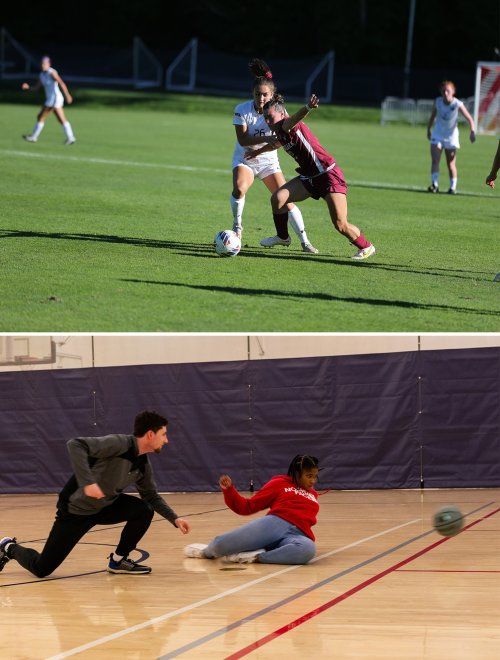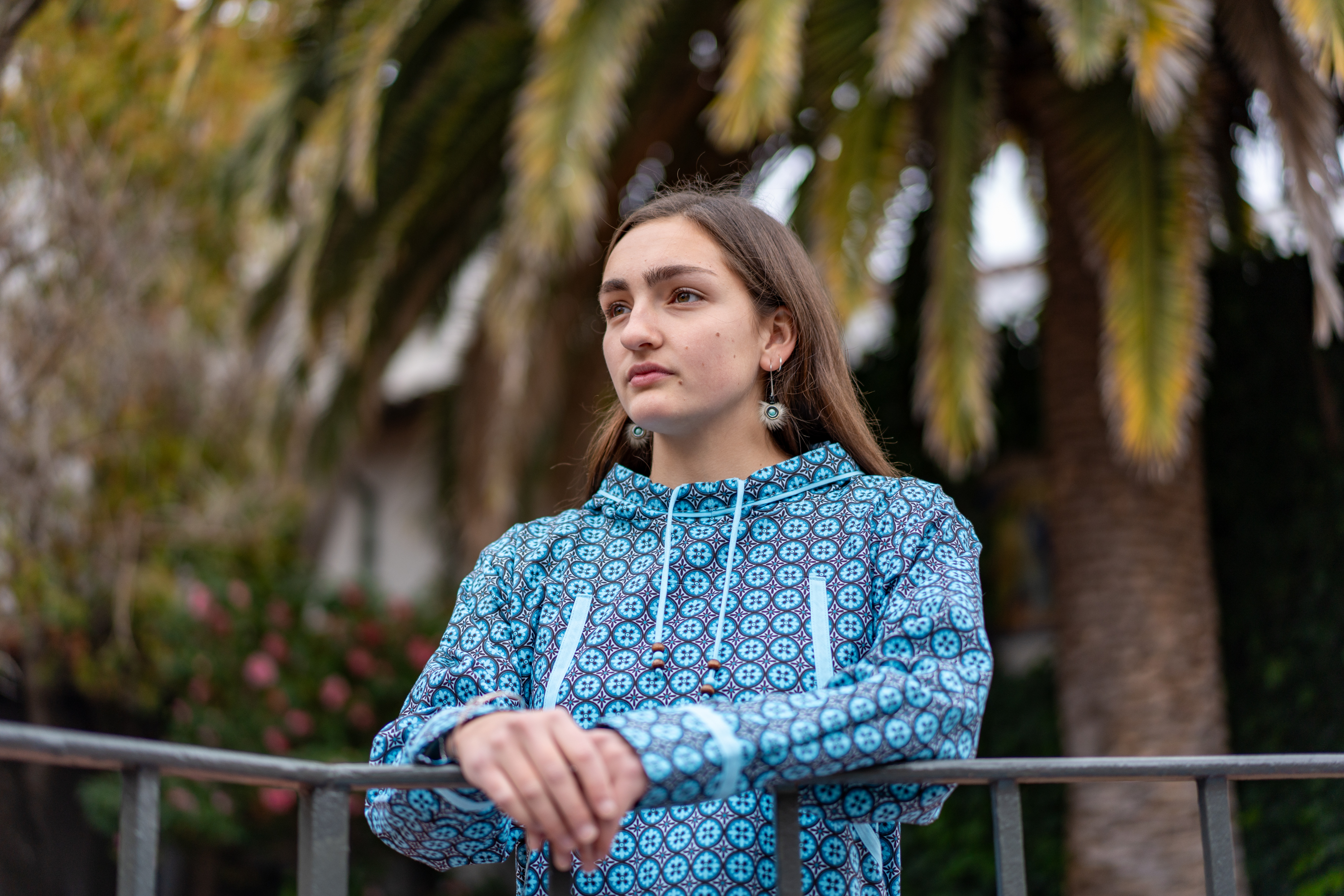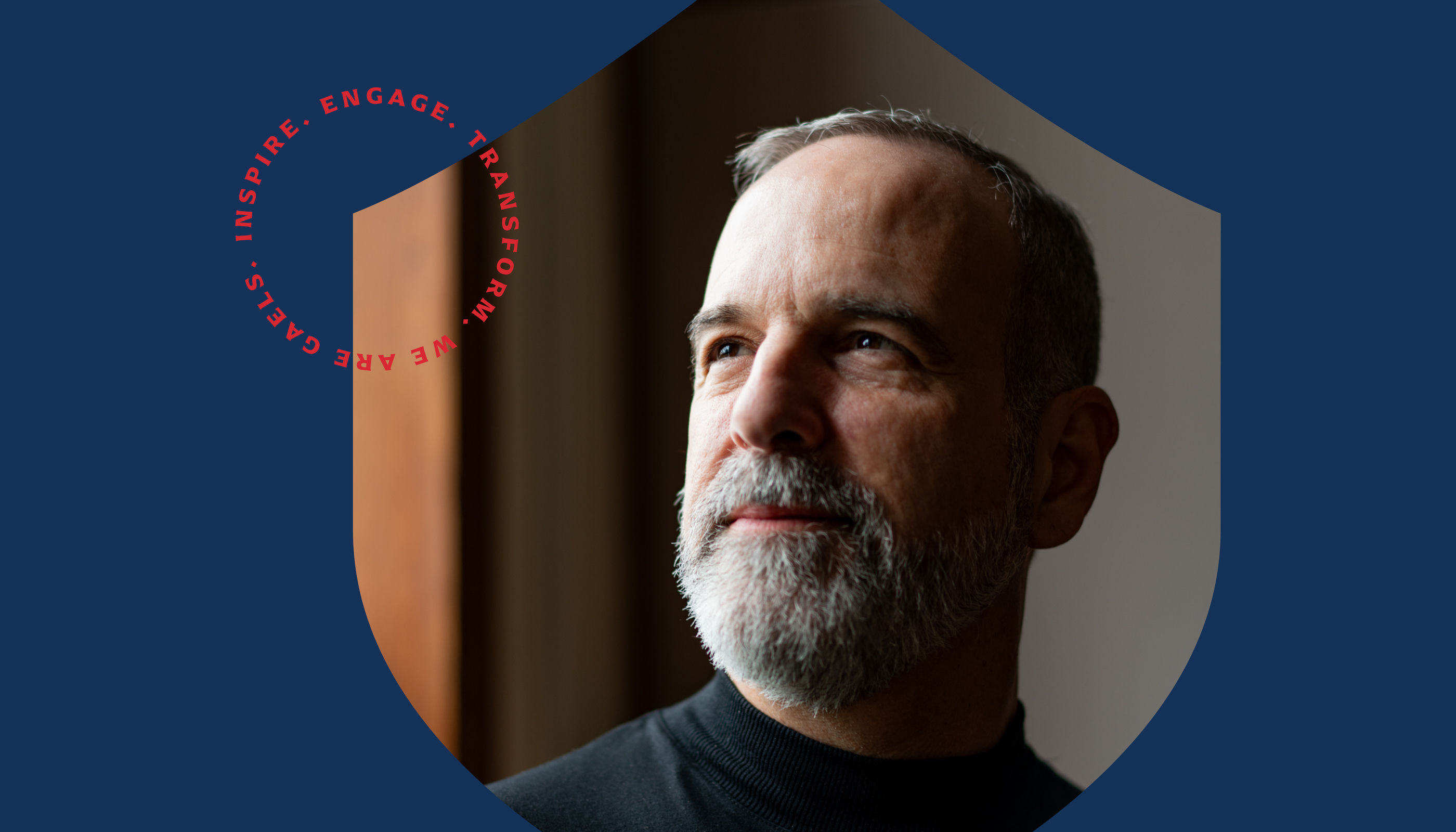
A Biology major and a transfer student, Amaya Simoni-Walters ’24 has dug into academics at Saint Mary's—and found something special in the community. “I feel like I know almost all my professors and classmates at Saint Mary’s,” she says. “They care when I'm not in class or if I’m performing poorly, and they check in with you. That's really different from how I've ever experienced school.” / Photo by Francis Tatem
In Their Own Words: Amaya Simoni-Walters ’24 on Bringing Her Native Experience to SMC, Biology, and Beyond
Like her mother, she's looking for ways to intertwine Native practices and knowledge with her passion for science. As President of SMC's Native American and Indigenous Student Association, too, she’s striving to create community and raise awareness.
(This story was previously published on May 30, 2024.)
In Their Own Words is a series in which we introduce you to the Gaels you need to meet—students, alums, faculty, and staff—and let them tell their stories, in their own words.
Meet Amaya Simoni-Walters ’25, a Biology major and transfer student, member of the Saint Mary’s Women’s Soccer team, and President of the Native American and Indigenous Student Association (NAISA). Simoni-Walters, who is Athabaskan and Yupik herself, is working toward a career in the sciences with the goal of actively implementing Native American health practices and cultural knowledge into contemporary communities.
Family Roots
I'm originally from Seattle, Washington, where I lived with my two moms and our dog, Koda. My parents are both professors. They used to work at the University of Washington, and now they work for the National Institutes of Health in Washington, DC, doing Behavioral Health Research.
My mom, Karina L. Walters, PhD, has been really impactful as an individual. She’s incredibly intertwined with Native health and Native communities; it’s literally her entire world. In addition to practicing modern medicine, Mom also practices traditional Indigenous medicine and healing. Because of her, I've always taken part in Native ceremonies and events. She took me to my first Powwow in Seattle when I was a baby. And ever since I was six, we’d spend a week every summer at the Blackfeet reservation in Browning, Montana. We’d stay with one of her teachers, helping the local community however we could.
Having that experience every summer since I was young has made me more aware of my own identity. A lot of times, I think I don't necessarily present Native compared to my mom. But I know that just because I might not look Native doesn’t negate the fact that I still have Native experience.
From Seattle to Gainesville to Moraga

I play soccer here on the SMC team now, but I originally attended the University of Florida on a soccer scholarship. A few months into my first semester, I knew it wasn't a good fit. Moving from Seattle to Gainesville was a huge cultural change for me, and I just found it really hard to connect with a lot of people there. I felt disconnected from my classes, too, where I was one of a hundred. I knew I needed a shift.
I honestly hadn't heard of Saint Mary's before I came here for soccer, but I think it has surprised me in a lot of good ways. I’ve really dug into my academics here, and I feel like I know almost all my professors and classmates at Saint Mary’s. Even people I have just a class or two with, I usually know about their family and their life, and they know about mine. They care when I'm not in class or if I’m performing poorly, and they check in with you. That's really different from how I've ever experienced school. It feels like a real community.
RNA Research with Dr. Ruff
One professor I’ve really connected with is Karen Ruff. We’ve been doing RNA transcription research together, where we try to make mutant transcend transcriptional factors for RNA and see how that affects gene expression. I met her through my introductory organic chemistry course. Now, I’ve worked with her for three years, and the research has really progressed: from making RNA, to testing the different units of gene expression, to now writing it all up and hopefully publishing it in a scientific journal. It’s all really fascinating to me. I definitely think I want to do lab work when I graduate.
Creating Community and Raising Awareness
The executive team we have at NAISA—Leonardo Ruiz Garcia ’25, Antony Yau ’26, and Alexis Hackett ’26—is small but incredible. They all work really hard, have a lot of fun ideas, and put a lot of effort into having people come to our events. We always want to make sure we’re trying to connect with as much of the Native American Indigenous population on campus as possible, which is unsurprisingly small. We’re also always trying to find anyone interested in being a member or just coming to events. Most of our events are focused on culturally educating people on Native American energy and indigenous experience. Last year, my mom gave a talk on her tribal health work. And Leo has been putting on events where we play a game called Pok-Ta-Pok, which is an ancient indigenous sport originally from Mesoamerica. It's kind of like basketball, but you can only hit the ball with your hips. We hold games in the Joseph Alioto Rec Center, about once every two months.
My mom and I also do smudging, which is basically taking sweetgrass, lighting it with fire to produce a little bit of smoke, and then putting it over your body to wash away any negative energy or tension in your body. I started doing that a couple of years ago, and then I brought it here to school. For me, NAISA has helped me recognize that I don't have to do that only in the presence of other Native people; I can be the Native person who brings my culture somewhere new.

Acknowledging Saint Mary’s Original Occupants
I’m hoping to get an official Saint Mary's land acknowledgment established before I graduate. It will be a symbolic first step, but even more important is what comes next.
It’s really crucial that we actually connect with the people whose land we’re acknowledging. That’s why NAISA met with the Muwekma Ohlone Tribe, the local Native community based in Concord. We asked them what would be the most helpful things for them: donations, or volunteer work, or hosting an educational experience. They provided us with a formal acknowledgment.
Just last month, SMC welcomed Terri Jett as the Associate Vice President/Senior Diversity Officer. I was introduced to her, and right away she asked to meet with our leadership team. Together we’ve already begun work on a plan for a land acknowledgment and other ways that Saint Mary’s can recognize and honor Native peoples.
Amaya Simoni-Walters '24 on sharing traditional Native practices with the SMC community: "For me, NAISA has helped me recognize that I don't have to do that only in the presence of other Native people; I can be the Native person who brings my culture somewhere new."
Next Steps and Carrying the Torch
I'm graduating a semester early, so I’ll be gone at the end of fall 2024. I’m planning on pursuing graduate studies in either stem cell research or marine biology. I’m not completely sure yet. Either way, I want my work to have a cultural link in Native American communities and populations. If I go into marine biology, I would love to explore Indigenous knowledge connected to living with animals in nature, for example, that can then be applied to other communities. I think there's a lot to be learned from that kind of local, generational wisdom.
One opportunity to utilize local Native wisdom is in Montana, where lots of towns are having problems with black bears coming down from the mountains in search of food. Their normal food sources are decreasing as temperatures increase. I want to be able to ask Native communities, “How have you coexisted with so many creatures over millennia, keeping their habitat functional without logging or damaging their entire home?”
It’s important that we seek out those carrying on the wisdom and traditions of Native American communities, I think. Even now, the number of people who retain that knowledge is dwindling. Like my mom, I want to help preserve it.
(This interview has been condensed and edited for clarity.)
Sam Nobile ’25 is studying English at Saint Mary’s and serves as a student writer with the Office of Marketing and Communications.



